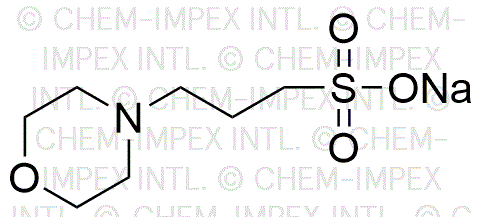MOPS sodium salt is widely utilized in research focused on
- Biological Buffers: It serves as an effective buffering agent in biological and biochemical research, maintaining stable pH levels in cell culture and enzyme reactions.
- Protein Studies: Commonly used in the formulation of buffers for protein electrophoresis, it helps researchers analyze protein behavior under various conditions.
- Pharmaceutical Development: In drug formulation, it aids in stabilizing active ingredients, ensuring consistent efficacy and safety in pharmaceutical products.
- Diagnostic Applications: Utilized in diagnostic kits, it enhances the reliability of assays by providing a controlled environment for biochemical reactions.
- Environmental Testing: Employed in environmental science, it helps maintain pH in samples during analysis, ensuring accurate results in water quality testing.
Información general
Propiedades
Seguridad y normativas
Aplicaciones
MOPS sodium salt is widely utilized in research focused on
- Biological Buffers: It serves as an effective buffering agent in biological and biochemical research, maintaining stable pH levels in cell culture and enzyme reactions.
- Protein Studies: Commonly used in the formulation of buffers for protein electrophoresis, it helps researchers analyze protein behavior under various conditions.
- Pharmaceutical Development: In drug formulation, it aids in stabilizing active ingredients, ensuring consistent efficacy and safety in pharmaceutical products.
- Diagnostic Applications: Utilized in diagnostic kits, it enhances the reliability of assays by providing a controlled environment for biochemical reactions.
- Environmental Testing: Employed in environmental science, it helps maintain pH in samples during analysis, ensuring accurate results in water quality testing.
Documentos
Hojas de datos de seguridad (HDS)
La SDS proporciona información de seguridad completa sobre la manipulación, el almacenamiento y la eliminación del producto.
Especificación del producto (PS)
La PS proporciona un desglose completo de las propiedades del producto, incluida la composición química, el estado físico, la pureza y los requisitos de almacenamiento. También detalla los rangos de calidad aceptables y las aplicaciones previstas del producto.
Certificados de análisis (COA)
Busque certificados de análisis (COA) ingresando el número de lote del producto. Los números de lote y de partida se pueden encontrar en la etiqueta de un producto después de las palabras "Lote" o "Lote".
Número de catálogo
Número de lote/lote
Certificados de origen (COO)
Este certificado de origen confirma el país en el que se fabricó el producto y también detalla los materiales y componentes utilizados en él y si se deriva de fuentes naturales, sintéticas u otras fuentes específicas. Este certificado puede ser necesario para cumplir con las normativas aduaneras, comerciales y regulatorias.
Número de catálogo
Número de lote/lote
Hojas de datos de seguridad (HDS)
La SDS proporciona información de seguridad completa sobre la manipulación, el almacenamiento y la eliminación del producto.
DownloadEspecificación del producto (PS)
La PS proporciona un desglose completo de las propiedades del producto, incluida la composición química, el estado físico, la pureza y los requisitos de almacenamiento. También detalla los rangos de calidad aceptables y las aplicaciones previstas del producto.
DownloadCertificados de análisis (COA)
Busque certificados de análisis (COA) ingresando el número de lote del producto. Los números de lote y de partida se pueden encontrar en la etiqueta de un producto después de las palabras "Lote" o "Lote".
Número de catálogo
Número de lote/lote
Certificados de origen (COO)
Este certificado de origen confirma el país en el que se fabricó el producto y también detalla los materiales y componentes utilizados en él y si se deriva de fuentes naturales, sintéticas u otras fuentes específicas. Este certificado puede ser necesario para cumplir con las normativas aduaneras, comerciales y regulatorias.


